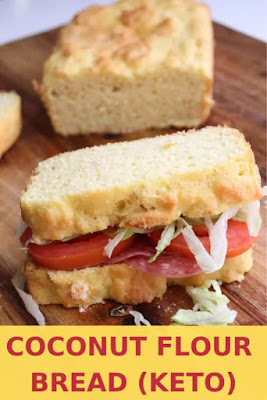Coconut Flour Bread (Keto, Low Carb, Paleo)
A coconut flour bread recipe that’s paleo friendly and low carb. It’s sure to become a favorite keto bread loaf for making sandwiches.
It’s really hard to give up bread and sandwiches with starting keto. That’s why you’ll want to try various low carb bread recipes to find one that works for you. For a tried and true recipe, I recommend the popular Soul Bread that was developed by a group of low carbers.
However, if you’re like me, you may be looking for a keto bread that’s also dairy-free. Unfortunately, Soul Bread relies on cream cheese, butter, and whey protein. Psyllium bread recipes typically contain no dairy, but finding psyllium can sometimes be a challenge.
INGREDIENTS :
- 6 Eggs
- 1/3 c coconut oil
- 1/3 c unsweetened almond milk
- 1/2 c coconut flour
- 1 tbsp baking powder
- 1 tsp xanthan gum See Note
- 1/4 tsp salt
INTRUCTIONS :
- Preheat oven to 350°.
- In a large bowl mix together eggs, coconut oil, and milk.
- Add in coconut flour, baking powder, xanthan gum, and salt.
- Stir until mixture thickens as the coconut flour absorbs the wet ingredients.
- In a greased bread pan (I used a 9×5-inch glass loaf pan), spread mixture evenly.
- Bake in the oven for 35-45 minutes. The top of the bread will be golden brown and a toothpick will come out clean when inserted.
- Allow to cool and enjoy!
NOTES :
If you can’t find xanthan gum or prefer not to use it, you can use about one tablespoon of any of the following instead:
ground flax seeds
chia seeds
psyllium husks
Variations to try:
Add in nuts and seeds
Sprinkle in about a teaspoon of cinnamon and two tablespoons sweetener
Make a sweet bread with 1/4 to 1/2 cup sweetener and a flavor extract
Recipe Adapted From Coconut Flour Bread
BERITA LENGKAP DI HALAMAN BERIKUTNYA
Halaman Berikutnya



0 Response to "Coconut Flour Bread (Keto, Low Carb, Paleo)"
Post a Comment